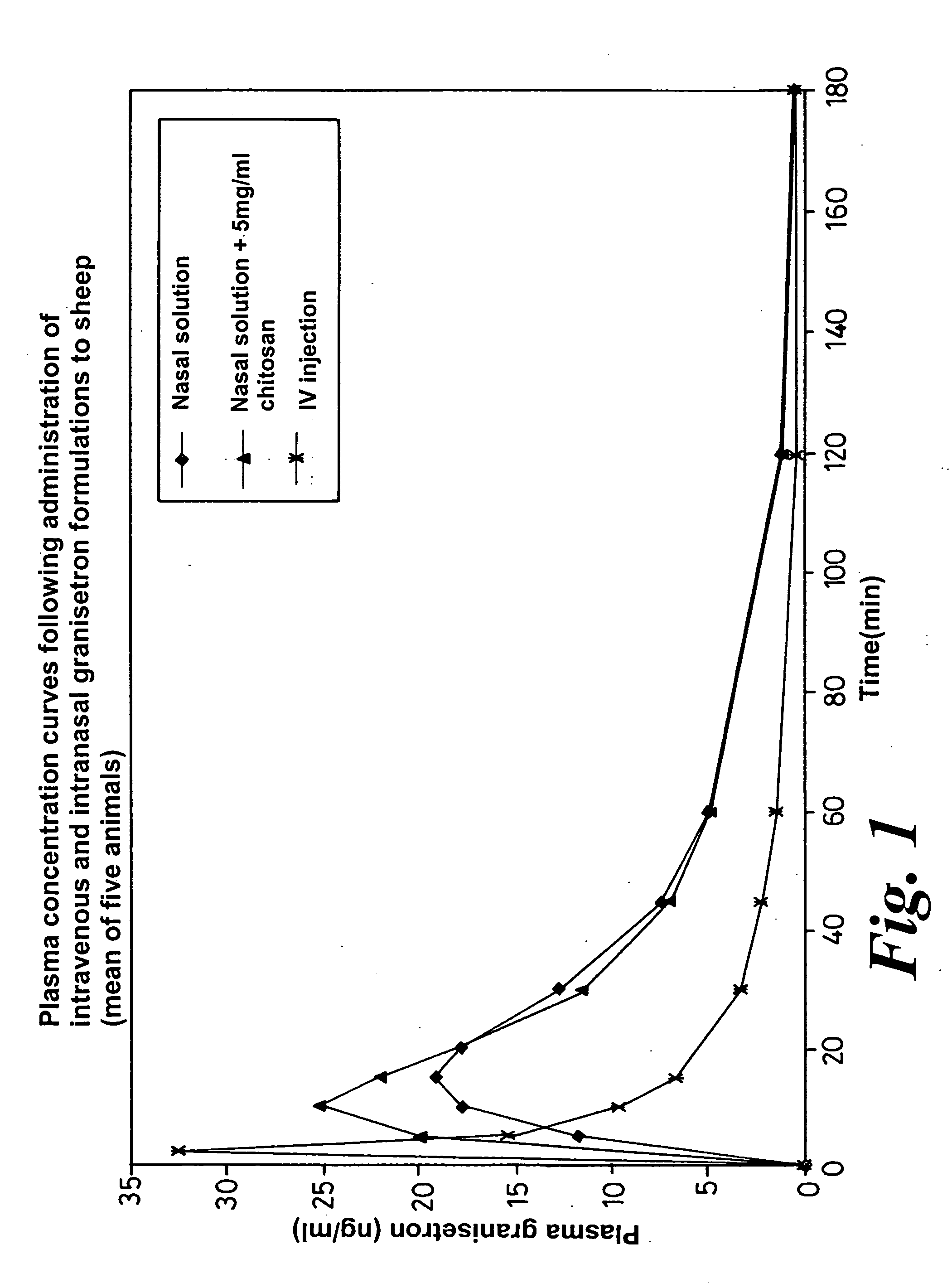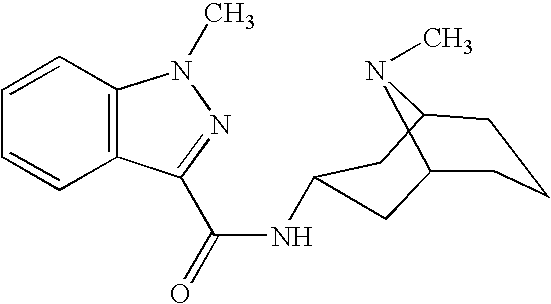Intranasal compositions
a technology of intranasal and composition, which is applied in the direction of drug composition, biocide, aerosol delivery, etc., can solve the problems of nausea and vomiting impairing the absorption of orally administered drugs, and achieve the effect of significant benefits and advantageous treatment or prevention of nausea and/or vomiting
- Summary
- Abstract
- Description
- Claims
- Application Information
AI Technical Summary
Benefits of technology
Problems solved by technology
Method used
Image
Examples
example 1
Intranasal Solution Containing 20 mg / ml Granisetron
[0062] 4.468 g of granisetron hydrochloride (ZMC, Hangzhou, China) was weighed into a 100 ml volumetric flask and 90 ml of water for injection (Baxter, Thetford, UK) was added. The flask contents were stirred until the drug had dissolved and then made to volume with water. This produced a stock solution containing 40 mg / ml granisetron (base).
[0063] 40 mg of sodium hydroxide (Fisher, Loughborough, UK) was weighed into a 100 ml volumetric flask and 90 ml of water for injection added. The flask contents were stirred until the sodium hydroxide had dissolved and then made to volume with water. This produced 0.01M sodium hydroxide solution.
[0064] 300 mg of 50% benzalkonium chloride solution (Albright & Wilson, Whitehaven, UK) was weighed into a 10 ml volumetric flask and 8 ml of water for injection added. The flask contents were stirred to disperse the benzalkonium chloride and then made up to volume with water. This produced a stock s...
example 2
Intanasal Solution 20 mg / ml Granisetron and 5 mg / ml Chitosan Glutamate
[0066] 250 mg of chitosan glutamate (Protasan UPG213, NovaMatrix, Drammen, Norway) was weighed into a 50 ml volumetric flask. 25 ml of 40 mg / ml granisetron stock solution (prepared in Example 1) and 15 ml of water for injection were added to the flask. The flask contents were stirred until the chitosan had dissolved. 0.5 ml of 15 mg / ml benzalkonium chloride stock solution (Example 1) and 0.327 g of sodium chloride were added to the flask containing chitosan and granisetron and the contents stirred until dissolved. The flask contents were made up to volume with water and the pH, osmolality and granisetron content (HPLC) measured. The pH was 4.85, the osmolality was 0.303 osmol / kg and the granisetron content was 20.0 mg / ml.
example 3
Pharmacokinetic Performance of Intranasal Granisetron Formulations in Sheep
[0067] The pharmacokinetic performance of the intranasal granisetron solutions described in Examples 1 and 2 was evaluated in sheep. For purposes of determining the absolute bioavailability of the intranasal doses, an intravenous injection of granisetron was administered. The injection product contained 1 mg / ml granisetron (Kytril® injection, Roche, Welwyn, UK).
[0068] A group of five female sheep was used, each weighing around 35 kg. The formulations were administered to a randomized cross-over design. Each intranasal formulation was administered at a granisetron dose of 8 mg. This dose was provided by administering 0.4 ml of each formulation via a spray device with the dose yolume being divided equally between both nostrils. The formulations were well tolerated by the sheep, as measured by the frequency of snorting and sneezing post-dose. For the intravenous dose, 2 ml of Kytril® injection (i.e. 2 mg of gr...
PUM
| Property | Measurement | Unit |
|---|---|---|
| concentration | aaaaa | aaaaa |
| concentration | aaaaa | aaaaa |
| concentration | aaaaa | aaaaa |
Abstract
Description
Claims
Application Information
 Login to View More
Login to View More - R&D
- Intellectual Property
- Life Sciences
- Materials
- Tech Scout
- Unparalleled Data Quality
- Higher Quality Content
- 60% Fewer Hallucinations
Browse by: Latest US Patents, China's latest patents, Technical Efficacy Thesaurus, Application Domain, Technology Topic, Popular Technical Reports.
© 2025 PatSnap. All rights reserved.Legal|Privacy policy|Modern Slavery Act Transparency Statement|Sitemap|About US| Contact US: help@patsnap.com


